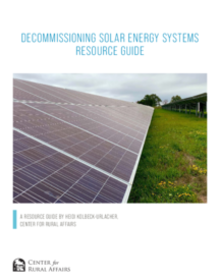Falling equipment costs coupled with increased demand for clean energy have led to a rapid rise in solar development over the past decade, a trend expected to continue. Although solar accounted for 3% of U.S. electricity in 2020, the U.S. Energy Information Administration projects that number will reach 20% by 2050. In 2022 alone, solar will account for nearly half of all new electric generating capacity.
Solar projects are often located in rural areas and can provide numerous benefits to nearby communities, including lease payments to landowners, tax revenue to fund infrastructure and services, and the creation of both permanent and temporary jobs.
County officials are typically responsible for enacting siting or zoning standards to help ensure solar development is supported by local residents. This can include planning for the eventual decommissioning of energy projects that have reached the end of their life cycles.
Policy


